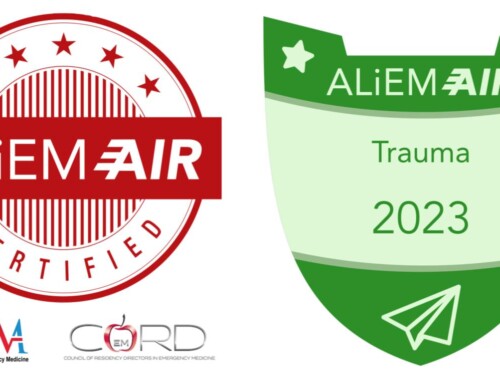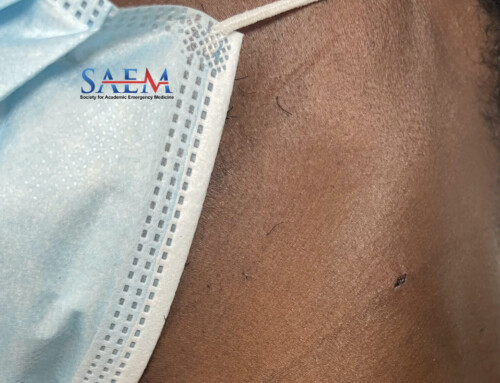 Blunt chest trauma from falls or motor vehicle collisions are a common reason for ED visits and a common source of rib fractures. While many patients with rib fractures can be discharged home with oral analgesics and an incentive spirometer, certain patients are at much higher risk for morbidity and mortality. This post will look at which patients are at risk, what factors predict increased mortality, and inpatient interventions that can reduce mortality, with a focus on the risks in older adults.
Blunt chest trauma from falls or motor vehicle collisions are a common reason for ED visits and a common source of rib fractures. While many patients with rib fractures can be discharged home with oral analgesics and an incentive spirometer, certain patients are at much higher risk for morbidity and mortality. This post will look at which patients are at risk, what factors predict increased mortality, and inpatient interventions that can reduce mortality, with a focus on the risks in older adults.
Age and Risk of Death with Rib Fractures
Worldwide, chest trauma accounts for 10%-15 of all ED trauma patients, and 20% of trauma deaths [3,8]. Not surprisingly, mortality following blunt chest trauma increases with age. Older adults with rib fractures are at increased risk for pneumonia, ARDS, and subsequent respiratory failure, and have longer hospital and ICU lengths of stay (LOS). A 10-year retrospective study of younger (18-64) and older (>64) cohorts of patients with comparable injury severity scores found that 17% of the younger cohort developed pneumonia, compared with 31% of the older adults. The mortality rate was 10% for younger adults, and 22% for the elderly (p<0.01) [1]. Mortality and rates of pneumonia also increased with the number of fractures. For each additional rib fracture, the odds ratio of pneumonia was 1.16 and for death was 1.19 [1].

Interestingly, when the number of rib fractures reaches 5-6, the mortality rates become more comparable for younger and older groups. This may be in part due to other trauma. For example, a patient with 5 rib fractures likely sustained a significant trauma and may have other injuries such as intra-cranial bleeds, or other thoracic or abdominal injuries. This held true in a study of about 65,000 patients with rib fractures in the National Trauma Database, which found that [2]:
Patients sustaining fractures of 6 or more ribs are at significant risk for death from causes unrelated to the rib fractures.
Predictors of Mortality in Blunt Chest Trauma
When evaluating a patient for possible discharge or admission after blunt trauma, you need to know which patients are at highest risk of pneumonia and death. A recent systematic review and meta-analysis sought to identify the factors that contribute to mortality after blunt chest trauma [3]. They found the following:
- Advanced age doubles your risk of death. Patients over 64 had an OR for death of 1.98 (1.86-2.11, 95% CI).
- Three or more rib fractures also doubles your risk of death, with an OR of 2.02 (1.89-2.15, 95% CI).
- Pre-existing cardiopulmonary disease, such as CHF gave an OR for death of 2.43 (1.03-5.72, 95% CI).
- Development of pneumonia has a huge impact on mortality, with an OR 5.24 (3.51-7.82, 95% CI). In the ED, after an initial trauma evaluation, of course, you will not know which patients will develop pneumonia. However, if a patient “bounces back” to the ED with pneumonia after blunt chest injury and fractures, you should have a very low threshold to admit the patient given the high OR for mortality, particularly if they are older, or have underlying lung disease.
Diagnosis of Rib Fractures
Many of the earlier studies of mortality and rib fractures relied on CXR alone to diagnose the fractures. CXRs pick up some of the more severe fractures, but screening CXRs can miss up to 50% of rib fractures [4]. As more and more patients are imaged with CTs, the mortality of rib fractures may appear to fall, since more subtle fractures are picked up. CT has the advantage of being able to better define whether there is parenchymal injury, and identify other intra-thoracic injuries, but may not add much over CXR in terms of prognostication [4]:
Although truncal CT scanning markedly improved the diagnosis and delineation of rib fractures, the screening CXR was a better predictor of subsequent pulmonary morbidity and mortality.
Ultrasound is also growing in popularity as a modality to diagnose rib fractures. However, its use is not currently widespread, and more research and training are needed.
Inpatient Interventions to Reduce Morbidity
Patients with rib fractures are at risk for pneumonia because of low tidal volumes as chest wall excursion is limited by pain and pneumonia is associated with higher mortality. By effectively reducing pain, rates of pneumonia and mortality may be reduced. Several studies have looked at epidural analgesia compared with IV pain medications. It was hoped that epidural analgesia would provide superior pain control and reduce rates of pneumonia. For example, in one randomized controlled trial patients with blunt chest trauma were assigned to either epidural or IV analgesia [5]. They found rates of pneumonia were 18% and 38% in the epidural and IV opioid groups respectively (adjusted OR of 6.0, p=0.05). The patients with epidural analgesia also had half as many days on the vent (p<0.001).
However, two subsequent meta-analyses have found no significant improvement in rates of pneumonia, hospital length of stay, ventilator-dependent days, or mortality with epidural analgesia compared with traditional IV opioids [6,7]. Overall the data was found to have a high risk of bias, and be of low quality, so in the future, one modality may still prove superior to the other. The main take-home point, however, is that patients need adequate analgesia so that they can breathe deeply and maintain good pulmonary function.
One way that mortality and hospital LOS have been improved for patients with rib fractures is with a multidisciplinary ‘clinical pathway’ algorithm approach [8] that involves early assessment of incentive spirometry volume, pain score, and cough strength. It them mobilizes services such as physical and occupational therapists (PT/OT) to improve mobility, respiratory therapists (RT) for a ‘Volume Expansion Protocol’, nutrition consults, and nursing assessments among other things. Use of this clinical pathway in a prospective cohort study showed a reduction in ICU LOS by 2.4 days (p=0.01), hospital LOS by 3.7 days (p=0.02), an OR for pneumonia of 0.12 (p<0.001), and a trend towards decreased mortality with OR 0.37 (p=0.06).
Summary
- Mortality in patients with rib fractures is high in older adults (20% mortality with 3-4 fractures).
- Risk factors for death include age >65 years, ≥3 fractures, underlying CHF, and development of pneumonia.
- In older adults with blunt chest trauma, have a low threshold for admission for patients with multiple fractures to optimize analgesia and pulmonary therapy.
- The data currently does not clearly support an advantage of epidural analgesia compared with IV opioids. A multidisciplinary approach with nursing, PT, OT, and RT to optimize pain control and pulmonary function can reduce mortality and hospital/ICU LOS.
References:
- Bulger EM, Arneson MA, Mock CN, Jurkovich GJ. Rib fractures in the elderly. J Trauma. 2000;48(6):1040-6; PMID 10866248
- Flagel BT, Luchette FA, Reed RL, et al. Half-a-dozen ribs: The breakpoint for mortality. Surgery. 2005;138(4):717-23; PMID 16269301
- Battle CE, Hutchings H, Evans PA. Risk factors that predict mortality in patients with blunt chest wall trauma: A systematic review and meta-analysis. Injury. 2012;43(1):8-17. PMID 21256488
- Livingston DH, Shogan B, John P, Lavery RF. CT diagnosis of rib fractures and the prediction of acute respiratory failure. J Trauma. 2008;64(4):905-911. PMID 18404055
- Bulger EM, Edwards T, Klotz P, Jurkovich GJ. Epidural analgesia improves outcome after multiple rib fractures. Surgery. 2004;136(2):426-430. PMID 15300210
- Carrier FM, Turgeon AF, Nicole PC, et al. Effect of epidural analgesia in patients with traumatic rib fractures: A systematic review and meta-analysis of randomized controlled trials. Can J Anaesth. 2009;56(3):230-242. PMID 19247744
- Duch P, Moller MH. Epidural analgesia in patients with traumatic rib fractures: A systematic review of randomised controlled trials. Acta Anaesthesiol Scand. 2015. PMID 25683770
- Todd SR, McNally MM, Holcomb JB, et al. A multidisciplinary clinical pathway decreases rib fracture-associated infectious morbidity and mortality in high-risk trauma patients. Am J Surg. 2006;192(6):806-811. PMID 17161098
Image Credits: 1, 2 and 3 derived from reference [1]




